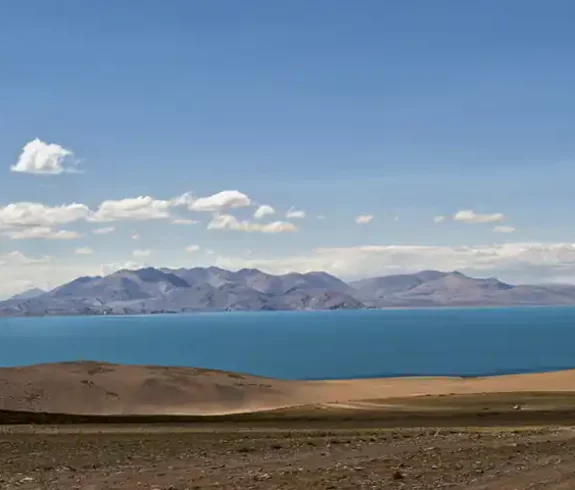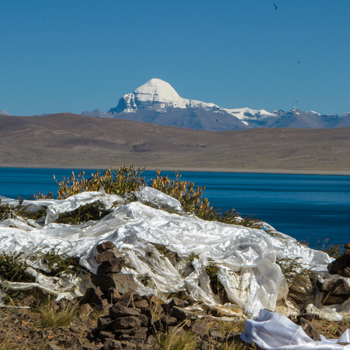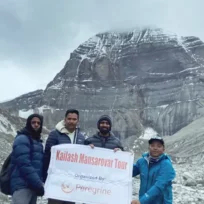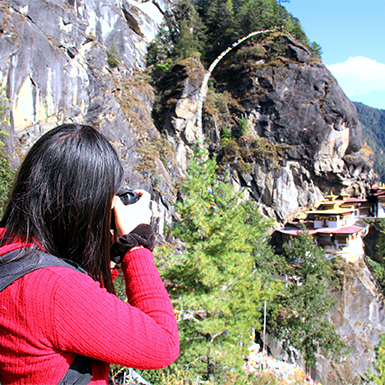Rakshastal, a saltwater lake shrouded in myth and history, rests on the Tibetan Plateau in China. The lake’s proximity to the sacred Mount Kailash and its celebrated counterpart, Lake Manasarovar, secures its unique geographical and mythology position.
Geography of Rakshastal Lake: A Closer Look
Located in the Ngari Prefecture of western Tibet, Rakshastal (also called Ravana Tal or Langa Tso) is roughly 4,590 meters (15,060 feet) above sea level, making it one of the world’s highest lakes. A narrow channel connects Ravan Tal to Lake Manasarovar, which lies a short distance away.
Ravan Tal, covering approximately 250 square kilometers (97 square miles), ranks among Tibet’s larger lakes. Its elongated and irregular shape, characterized by a barren shoreline and a dramatic backdrop of mountains, creates a captivating landscape.
Unlike the freshwater Manasarovar, Ravan Tal contains saltwater. This high salt content forms a harsh environment, limiting plant and animal life and contributing to its stark and almost alien landscape.
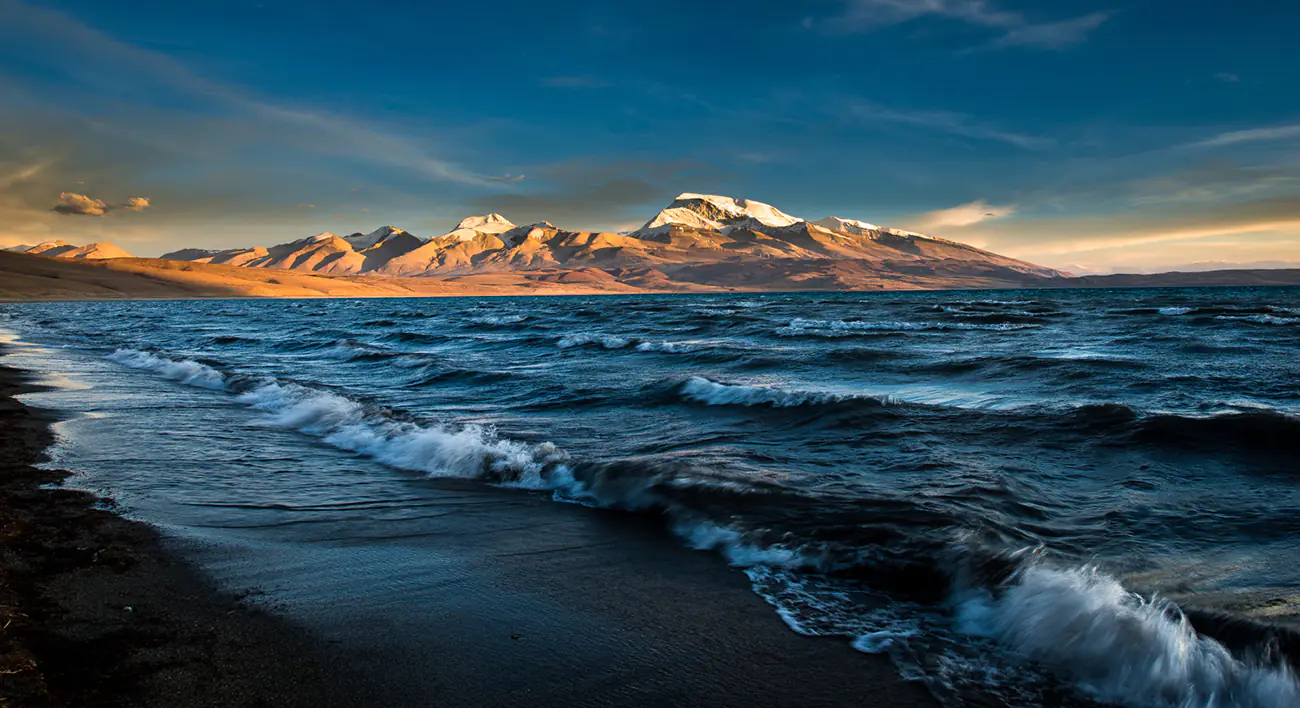
Legends and Contrasting Significance of Tibet’s Saltwater Lake
Unlike the holy Lake Manasarovar nearby, Rakshastal does not hold religious significance. Its stark beauty, surrounded by windswept plains, contrasts sharply with Manasarovar’s lush greenery. The water itself presents the most notable difference: Manasarovar’s freshwater, considered sacred, contrasts with Ravan Tal’s salty water, which remains a mysterious element waiting for exploration.
Mythological Stories of Rakshastal: The Demon King’s Domain
- Ravana’s Penance: Hindu mythology closely associates Rakshastal with Ravana, the ten-headed demon king of Lanka, giving the lake its mysterious and ominous reputation. Legend has it that Ravana performed intense austerities on the shores of this lake to appease Lord Shiva. Some tales even suggest that the lake formed from Ravana’s tears or that he made daily offerings to Shiva at this very spot.
- The Lake of Demons: ” Rakshas Tal” translates to “Lake of the Demon,” reflecting its association with negative energies and evil forces. It starkly contrasts the sacredness and purity attributed to nearby Lake Manasarovar.
- Symbolism of Duality: Its mythological ties to Ravana and its barren, desolate landscape create a powerful juxtaposition to Manasarovar’s lushness and association with gods and goddesses. This duality mirrors the balance between good and evil, light and dark, a central theme in many spiritual traditions.
Cultural Significance: Rakshastal vs Manasarovar
Different traditions deeply embed the contrasting symbolism of Rakshastal vs Manasarovar in their cultural significance:
- Manasarovar: Revered as sacred in Hinduism, Buddhism, Jainism, and Bön traditions, Manasarovar represents purity, enlightenment, and spiritual liberation. Pilgrims circumambulate its shores as a form of devotion and seek its waters for blessings.
- Ravan Tal: While not a pilgrimage site, Ravan Tal is culturally significant. It reminds visitors of the darker aspects of human nature and the forces of negativity in the world. Some visitors believe that experiencing the stark beauty of Ravan Tal can lead to greater self-awareness and a deeper understanding of life’s challenges.
A Geological and Ecological Exploration of Tibet’s Saltwater Lake
Rakshastal, a saltwater lake on the Tibetan Plateau, offers more than mythological intrigue. Its distinctive geological formation and unique environmental characteristics set it apart from its freshwater neighbor, Manasarovar.
Geologic Forces Shape Ravan Tal Lake
Tectonic activity, the powerful force that sculpted the Himalayan mountains, also birthed Ravan Tal. The lake occupies a depression created by shifting tectonic plates millions of years ago. Glacial meltwater and precipitation filled this basin, making the lake. Over time, fluctuating climates and ongoing geological processes have altered the lake’s water levels and salinity.
As an endorheic lake, it has no water outlet. Instead, evaporation is the primary means of water loss, leading to a high concentration of dissolved minerals and salts within the lake.
Water’s Unique Characteristics: The Salty Tale
Rakshas Tal is a saltwater lake, significantly saltier than Manasarovar. This high salt content makes the water undrinkable and inhospitable to most aquatic life. The lake teems with dissolved minerals like sodium chloride (salt), potassium, and magnesium, contributing to its unique color and limited biodiversity.
Freshwater symbolizes purity and life in many cultures, while saltwater is often associated with barrenness and desolation. This contrast in symbolism partly explains why Ravan Tal holds a different spiritual significance than Manasarovar.
Life in a Harsh Environment: Flora and Fauna
The extreme salinity and harsh temperatures of Ravan Tal create a challenging environment for most life forms. The lake lacks the abundant fish and aquatic life found in freshwater ecosystems. However, hardy microorganisms like algae and bacteria thrive in the salty waters, forming the foundation of a simple food web that supports a few bird species.
Despite the demanding conditions, it is a crucial stopover for migratory birds, especially during warmer months. Brown-headed gulls and bar-headed geese are among the resilient species that frequent the lake’s shores. The surrounding landscape features sparse vegetation, mainly hardy grasses and shrubs adapted to the salty soil and harsh climate.
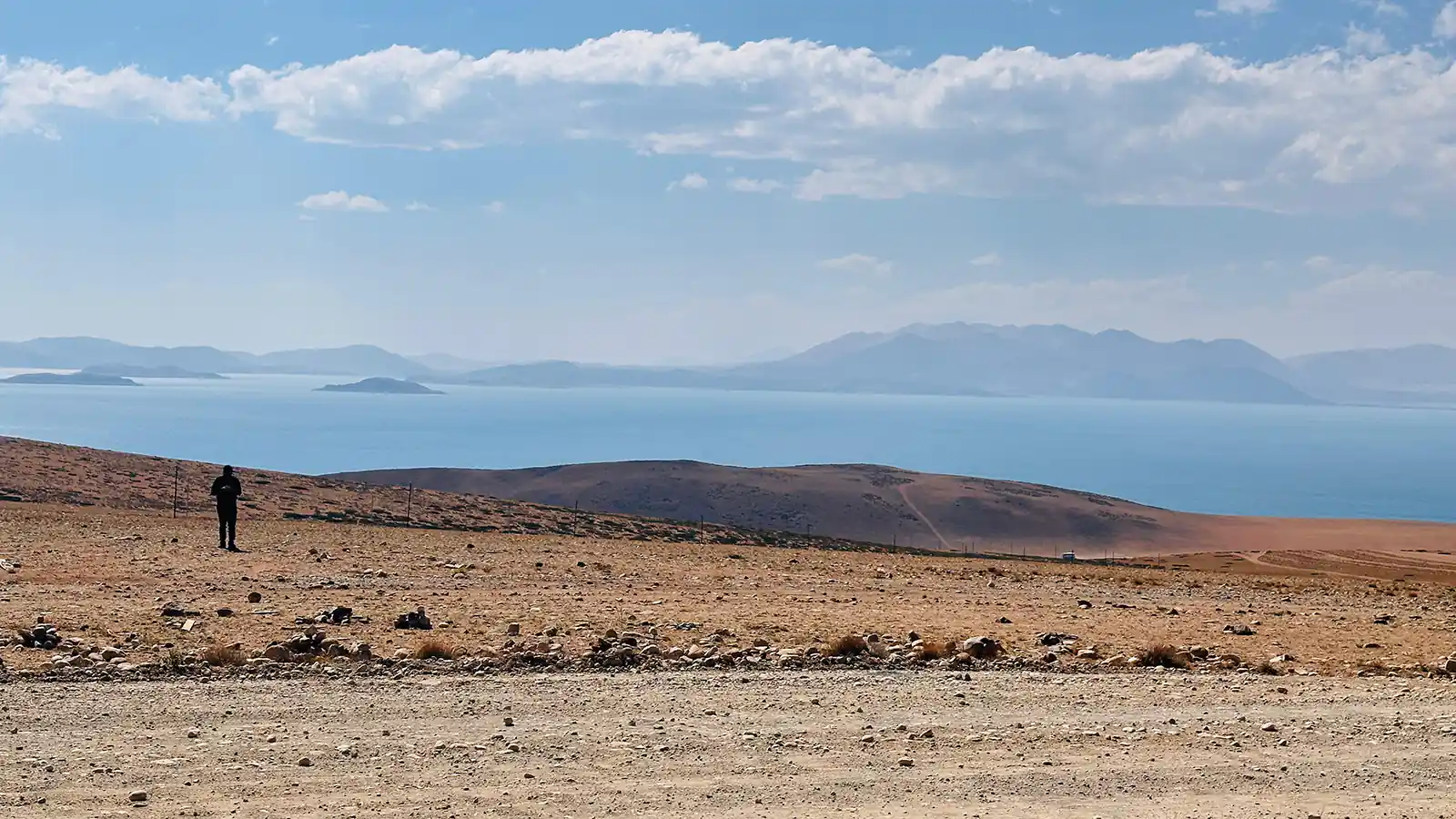
Rakshastal’s Mystique and Local Beliefs: A Tale of Two Lakes
Rakshastal, a saltwater lake on the Tibetan Plateau, is unique in local lore and beliefs. Its stark beauty and desolate landscape are entwined with myths and legends, creating a contrasting image to its neighboring freshwater counterpart, Lake Manasarovar. This duality forms a fascinating narrative that has captivated travelers and pilgrims for centuries.
Beliefs About Ravan Tal’s Malevolent Nature
- The Lake of Demons: Rakshas Tal’s name translates to “Lake of the Demon,” and this title reflects the deep-rooted beliefs associated with it. The lake often serves as a dwelling place for evil spirits and negative energies, starkly contrasting with the positive energy related to Manasarovar.
- Forbidden Waters: Unlike the sacred waters of Manasarovar, where pilgrims bathe and collect water for its purifying properties, Rakshas Tal’s waters are considered taboo. Local traditions warn against disturbing the lake’s tranquility or venturing too close to its shores, lest one risks angering the spirits said to dwell within.
- Tales of Ill Fortune: Stories abound of individuals who have defied the lake’s mystique only to meet with misfortune or illness. These cautionary tales underscore the significance of treating the lake with reverence and respecting its power.
Contrasting Views: Rakshastal vs. Manasarovar
The juxtaposition of Rakshas Tal vs Manasarovar reveals a fascinating dichotomy in terms of both physical appearance and spiritual significance.
- Manasarovar: Revered as sacred in Hinduism, Buddhism, Jainism, and Bön traditions, Manasarovar represents purity, enlightenment, and spiritual liberation. Pilgrims circumambulate its shores as a form of devotion and seek its waters for blessings. The lake’s freshwater and lush surroundings symbolize life, purity, and the divine.
- Rakshas Tal: While not a pilgrimage site, Rakshastal is culturally significant. It reminds visitors of the darker aspects of human nature and the forces of negativity in the world. Some visitors believe that experiencing the stark beauty of Ravan Tal can lead to greater self-awareness and a deeper understanding of life’s challenges. The lake’s saltwater and barren landscape symbolize the harsh realities of existence.
Rakshastal Tourism and Accessibility: A Guide to the Lake of Demons
Discover the mysteries of Rakshas Tal, the enigmatic saltwater counterpart to the sacred Manasarovar, on an unforgettable adventure in Tibet. Located in Tibet, this remote destination requires careful planning. This comprehensive Rakshastal travel guide helps you navigate the logistics and discover nearby attractions, ensuring a rewarding tour.
Permits and Transportation
Gaining access to Rakshas Tal involves obtaining permits and arranging transportation.
- Obtain Permits: Foreign visitors must secure a Tibet Travel Permit and an Aliens’ Travel Permit before traveling to Rakshastal.
- Partner with Travel Agencies: Collaborating with a reputable travel agency specializing in Tibet streamlines the permit process, transportation, and logistics for a seamless experience.
- Choose Your Transportation: Most travelers access Ravan Tal via road from Lhasa, the capital of Tibet. This multi-day trip traverses scenic mountain passes. Alternatively, consider helicopter tours for a faster, albeit more expensive, option.
Best Times to Visit
- May to September: The May to September season boasts the most favorable weather conditions for exploring Rakshas Tal, with milder temperatures and less chance of snow or ice. Expect milder temperatures and fewer chances of snow and ice, making travel and exploration more enjoyable.
- Festivals: If you wish to experience Tibetan culture firsthand, schedule your visit to coincide with local festivals, such as the Saga Dawa Festival in May or June. It allows you to witness vibrant traditions and rituals.
Nearby Attractions: Enhance Your Tibetan Journey
Rakshastal is a captivating destination, but take the chance to explore nearby attractions that offer a deeper understanding of Tibet’s natural and cultural wonders.
- Lake Manasarovar: Explore the sacred freshwater lake Manasarovar, located a short distance from Rakshas Tal. Experience the stark contrast in landscape and spiritual significance between these two lakes.
- Mount Kailash: A must-visit pilgrimage site for Hindus, Buddhists, Jains, and Bön followers, Mount Kailash is a must-see. Combine your Rakshastal trip with a kora (circumambulation) around this revered peak.
- Guge Kingdom Ruins: Uncover the remnants of the ancient Guge Kingdom, offering a glimpse into Tibet’s rich history and cultural heritage.
- Everest Base Camp: After visiting Rakshastal, the adventurous traveler should consider a trek to Everest Base Camp, one of the world’s most iconic mountaineering destinations.
Balancing Tourism and Conservation on the Tibetan Plateau
Rakshastal Lake, a unique saltwater gem on the Tibetan Plateau, faces a delicate balance between welcoming visitors and protecting its fragile ecosystem. Understanding the environmental challenges and promoting responsible tourism is crucial for preserving this extraordinary destination for future generations.
Environmental Pressures Threaten Rakshastal’s Ecosystem
Rakshas Tal’s delicate ecosystem faces various threats:
- Climate Change: Rising temperatures on the Tibetan Plateau accelerate glacial melting, altering Ravan Tal’s water levels and salinity. Shifting precipitation patterns further disrupt the lake’s intricate ecosystem.
- Pollution: While Rakshas Tal remains relatively untouched, many visitors raise concerns about waste disposal and vehicle emissions pollution.
- Overgrazing: Livestock grazing around the lake can lead to soil erosion and damage natural habitats, further straining the vulnerable ecosystem.
- Infrastructure Development: Building roads and other infrastructure, while essential for tourism, can disrupt natural habitats and increase pollution if not carefully managed.
Conservation Efforts: Safeguarding Rakshastal’s Unique Environment
Conservationists and the Chinese government are working to protect Rakshastal’s delicate ecosystem:
- Protected Areas: While specific regulations for Rakshas Tal are limited, the Chinese government has established protected areas across the Tibetan Plateau to safeguard biodiversity and fragile ecosystems.
- Research and Monitoring: Scientists actively monitor Rakshas Tal’s water quality, ecological health, and the impact of climate change. This data guides the development of effective conservation strategies.
- Community Engagement: Local communities are vital partners in protecting Rakshastal. Education programs empower residents with knowledge about the lake’s importance, while initiatives foster sustainable tourism practices within the community.
Tourism’s Impact: A Double-Edged Sword
Tourism brings both opportunities and challenges to Rakshas Tal.
- Positive Impacts: Tourism can boost awareness of Rakshastal’s unique ecosystem and cultural significance, generate income for local communities, and support conservation initiatives.
- Adverse Impacts: Unmanaged tourism can lead to increased pollution, wildlife disruption, and natural landscape degradation.
Responsible Tourism: A Sustainable Path Forward
Responsible tourism is essential for ensuring the long-term health of Rakshas Tal. Visitors can play a vital role in its preservation by:
- Minimizing Waste: Pack out all trash and avoid single-use plastics to reduce your environmental footprint.
- Respecting Wildlife: Observe animals from a distance and avoid disturbing their natural behaviors.
- Following Regulations: Adhere to local regulations and guidelines regarding camping, hiking, and other activities to protect the fragile environment.
- Supporting Conservation: Contribute to local conservation efforts by donating to reputable organizations or participating in volunteer programs.
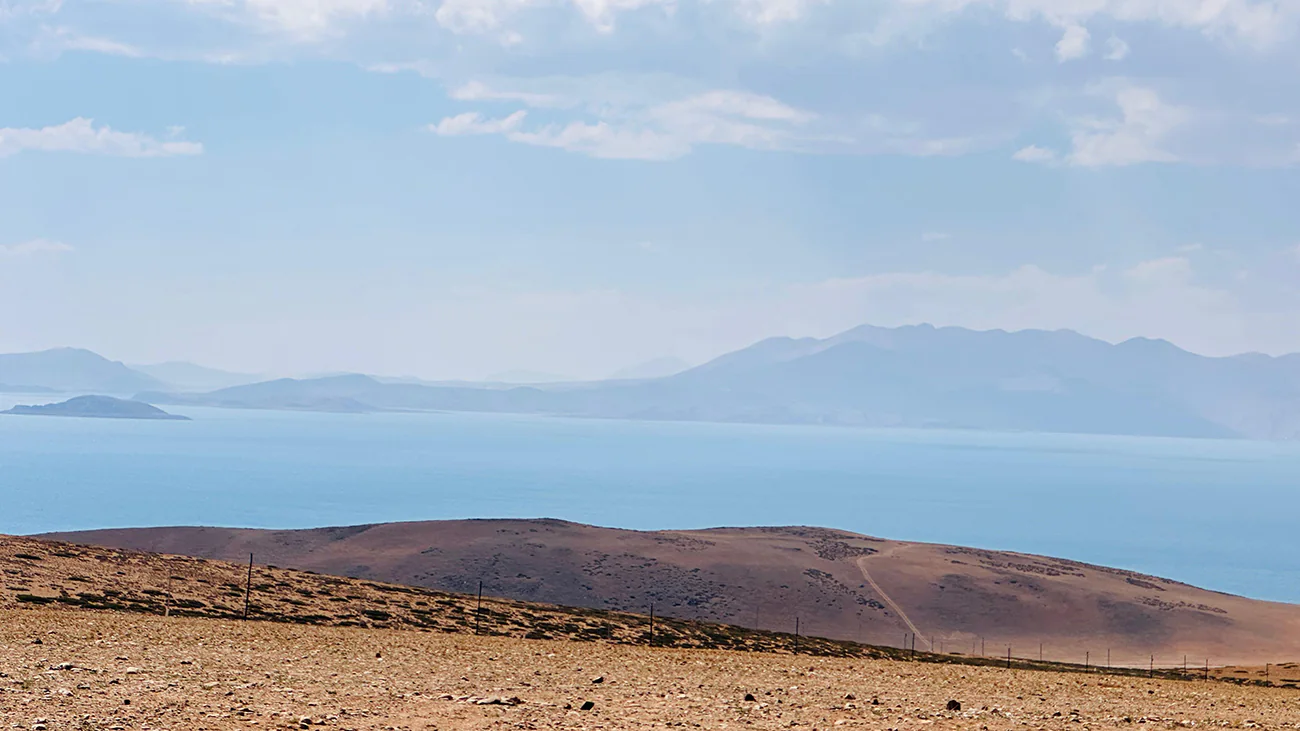
Photography and Observation Guide: Capture the Demon Lake’s Magic
Rakshas Tal, Tibet’s ethereal saltwater lake, offers photographers and nature enthusiasts a captivating experience. Use these tips to capture the essence of this unique landscape and observe its hidden wonders.
Photography Tips: Capture Rakshastal’s Haunting Beauty
- Wide-Angle Lens: Embrace Rakshastal’s vastness with a wide-angle lens, capturing expansive skies, rugged mountains, and the lake’s reflective surface in a single, breathtaking frame.
- Golden Hour Light: Harness the warm, ethereal light of sunrise and sunset. These golden hours cast dramatic shadows and infuse vibrant colors into your Rakshastal photos.
- Long Exposure Magic: Experiment with extended exposure techniques to create a sense of movement in the water and clouds, adding an otherworldly feel to your images.
- Filter for Perfection: Employ a polarizing filter to reduce glare and enhance the color saturation of the sky and water. A neutral density filter is helpful for long exposures in daylight.
- Compose with Care: Mindful composition is vital. Include foreground elements like rocks or vegetation to add depth and interest to your photographs.
Observational Points: Uncover Rakshastal’s Secrets
Rakshas Tal offers various vantage points from which to observe its unique landscape and wildlife.
- Chiu Gompa Monastery: Perched above Rakshastal, the ancient Chiu Gompa Monastery offers sweeping lake vistas, and the majestic mountains encircle it. Absorb the serene atmosphere and learn about the lake’s cultural significance.
- Lakeshore Hikes: Explore the lake’s shoreline on foot, observing birdlife, including migratory species like brown-headed gulls and bar-headed geese.
- Camping: Experienced campers with permits can experience the full splendor of Rakshastal’s natural beauty firsthand. The clear night skies offer unparalleled stargazing opportunities.
Prepare for Rakshastal’s Unique Environment
When visiting Rakshas Tal, expect:
- Stark Beauty: The lake’s barren landscape, windswept shores, and unique light create a hauntingly beautiful scene, contrasting sharply with Manasarovar’s lushness.
- Sparse Wildlife: While wildlife is less abundant here than in other parts of Tibet, you might spot migratory birds, marmots, and other hardy creatures adapted to this harsh environment.
- Cultural Significance: Delve into the lake’s mythological connection to Ravana and its role in local beliefs. A local guide can deepen your appreciation for the region’s cultural heritage, offering unique insights and stories.
- Challenging Conditions: Rakshas Tal’s high altitude and unpredictable weather demand preparation. Pack warm clothing and sun protection, and be ready for cold temperatures and strong winds.
Exploring the “Lake of the Demon” Safely and Respectfully
Rakshastal Lake, the enigmatic saltwater counterpart to sacred Lake Manasarovar, is a captivating destination on the Tibetan Plateau. This travel guide provides practical tips and safety considerations to ensure a smooth and respectful visit to this awe-inspiring location.
Practical Tips for Visiting
Permits and Documentation
- Tibet Travel Permit: All foreign visitors must obtain this permit before entering Tibet.
- Aliens’ Travel Permit: Required for travel within Tibet, including Ravan Tal.
- Partner with a Travel Agency: To streamline the permit process and ensure a hassle-free trip, consider engaging a reputable travel agency specializing in Tibet tours.
Transportation
- Road Trip from Lhasa: The most common route to Rakshas Tal is a multi-day road trip from Lhasa, the capital of Tibet. This tour traverses stunning mountain passes and provides glimpses of Tibetan life.
- Helicopter Tours: Some tour operators offer helicopter tours to Rakshastal for those short on time or seeking a bird’ s-eye view of the landscape.
Accommodation
- Guesthouses and Hotels: Limited options exist in nearby towns like Darchen. Choose from guesthouses or basic hotels for a comfortable stay.
- Camping (with Permits): If you’re an experienced camper and have obtained the necessary permits, you can camp near Rakshas Tal. However, be well-prepared for the harsh high-altitude conditions.
Local Customs and Etiquette
- Respectful Attire: Dress modestly, covering your shoulders and knees, as a sign of respect for Tibetan culture.
- Religious Observances: Avoid touching religious objects without permission and be mindful of local customs when visiting monasteries or other sacred sites.
- Photography Etiquette: Always ask before taking photos of people, especially monks and nuns.
Safety Considerations for Rakshastal Visitors
- Altitude Acclimatization: Rakshastal’s high altitude can cause altitude sickness. Gradual acclimatization is crucial. Allow yourself several days to adjust before engaging in strenuous activities. Drink plenty of water, avoid alcohol, and monitor your body for any symptoms of altitude sickness.
- Weather Preparedness: The weather in this region is unpredictable, even during the warmer months. Pack warm layers, waterproof gear, a hat, gloves, and sunscreen. Be prepared for cold temperatures, strong winds, and intense sunlight.
- Guided Tours: Expert guides ensure your safety on challenging terrain and provide invaluable knowledge that enriches your experience.
- Emergency Preparedness: Carry a basic first-aid kit with essential medications and a satellite phone or other communication device in emergencies. Remember, medical facilities are limited in remote areas.
Rakshastal and Manasarovar: A Tale of Two Tibetan Lakes
Rakshastal and Manasarovar, twin lakes nestled in the heart of Tibet near the sacred Mount Kailash, offer contrasting experiences for adventurous travelers and spiritual pilgrims alike. Both lakes boast stunning natural beauty but diverge in spiritual significance, visitor experiences, and physical characteristics.
Spiritual Significance: Light Meets Darkness
- Manasarovar (The Lake of the Mind): Hindus, Buddhists, Jains, and Bön practitioners revere Manasarovar as a holy lake, symbolizing purity and spiritual enlightenment. Pilgrims circle its shores in devotion, seeking blessings and purification in its sacred waters. Like Lord Shiva, the lake’s association with deities reinforces its holy status.
- Rakshastal (The Lake of the Demon): In contrast, Rakshastal mythology links the lake to negative energies and evil spirits in Hindu lore. Its name, “Lake of the Demon,” reflects this association. Local traditions caution against disturbing its waters or shores, as it’s believed to be the abode of these spirits.
Visitor Experience: Pilgrimage vs. Contemplation
- Manasarovar: Visiting Manasarovar is a profoundly spiritual pilgrimage. Pilgrims perform rituals, including bathing in the lake, offering prayers, and circumambulating its sacred shores. The atmosphere fosters devotion and spiritual seeking.
- Rakshastal: While not a pilgrimage site, Rakshas Tal offers a unique experience of solitude and reflection. Visitors find solace in the stillness and vastness of its stark beauty, encouraging contemplation about the darker aspects of life and human nature.
